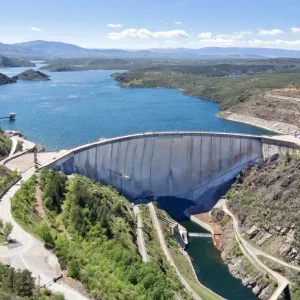China’s first concrete faced rockfill dam (CFRD) was at Kekeya: this dam, 41.5m high with a chess boarded concrete face slab, was completed in 1982. Since 1985 a number of CFRDs have been constructed comprising compacted rockfill, with a semi-pervious filter grading face zone, monolithic face slab, dowelled and grouted toe slab (plinth), and multiple water stop perimeter joint. The first modern CFRD, the 58.5m high Guanmenshan, was completed in 1998.
By 1999 39 dams of this type had been completed in China, 14 of which have a height over 70m. In addition, there are 35 dams under construction (including Tianshengqiao, known as TSQ-1) and 20 dams, all over 100m high, at the planning stage.
The CFRD has been used for many different purposes and different sizes of reservoir, from small irrigation projects to large reservoirs on main rivers, as well as for large pumped storage power projects. In one case, a CFRD was used at Hengshan to raise an old earth-core rockfill dam from 48.2m to 70.2m high.
Among notable current projects, TSQ-1 has a reservoir with storage area of 10,300M m3, a dam 178m high, a spillway with capacity of 21,750m3/sec, and generating capacity of 1200MW. Construction began in 1998 and is to be completed this year. Maximum leakage is only 45l/sec at 20m above normal water level.
The Shuibuya dam has also now been finalised: at 233m, this will be the highest CFRD to be built in China.
The increased use of CFRD mainly results from its low cost and short schedule, as compared to the earth-core rockfill dam. In the case of TSQ-1, for example, appropriate qualities and quantities of earth-core material are available near the site, but the CFRD can be completed a year earlier, and at a cost 12% lower (neglecting the contingency aspects). In practice, the river was blocked for the TSQ-1 project in December 1994, and diversion tunnels were plugged off in December 1997. The first unit started generating power in December 1998. The critical path for generation was not the construction of the dam but of the power facilities.
Based on the experience gained from China’s CFRDs, especially from the TSQ-1 project, building a 233m high CFRD at Shuibuya is a reasonable next step in China. It will, however, be a challenge as it is 31% higher than TSQ-1. At present the highest dam in the world is at Aguamilpa, which is 187m high, but the main embankment material at that site is river gravel, which is less compressible than the limestone rockfill for TSQ-1 and Shuibuya.
Main design features
China’s CFRDs are designed in accordance with the Design guide for concrete faced rockfill dams (1993), and Design code for design of concrete faced rockfill dams (1999), both of which were approved and published by the State Power Corporation of China and the Ministry of Water Resources. There are many design and research institutes in China engaging in this new type of dam. The Design guide and Code were used to reflect the state-of-art in this field both from Chinese practice and from other countries.
The design guide and code are critically necessary in China. As is well known, the 70m Gouhou dam was completed in 1989 and failed in 1993. One of the main causes was the lack of the provision of an internal chimney drain in the sandy gravel fill. Leakage from the joint between the crest parapet and face slab appeared at the downstream slope and caused piping of the material. Meanwhile, upstream undermining destroyed the gravel support underneath the face slab. The slab collapsed due to reservoir water pressure, and as a consequence the dam was overtopped. The overtopping caused the dam to fail within two hours. According to the designer, the dam was completed too early to meet the Design guide.
The main features of the Code are briefly described below.
China’s Code
Concrete faced rockfill dams have evolved to a stage where the main elements are common, and a typical cross sections of a CFRDs with sound rockfill on bedrock and with gravel fill on alluvium are shown at left. Both types of figures are specified in the Code.
Learning the lessons of Gouhou dam, the importance of seepage control has been emphasised in the Code. The Code requires the cushion zone material to be internally stable, and have self-filtering properties. The interfaces of the cushion zone and transition zone, and of the transition zone and main rockfill zone, should meet filter criteria. The Code requires the cushion material to have a permeability of 10-3-10-4cm/sec for a concrete faced gravel-fill dam, but states that this level is also desirable for a CFRD (including that for the pumped storage reservoir). The Code requires the content of fine particles to be low enough to avoid additional settlement of the face slab (induced by seepage erosion of the transition and main rockfill materials), and specifies an upper limit of 20% for particles less than 5mm. The grading of cushion zone 2A has been specified in the Code by our laboratory test. The specified grading envelopes are very close to Sherard’s grading envelopes. The specified grading for zone 2B is the same as that for downstream fine filter for an earth-core rockfill dam.
In our opinion, leakage is an economic problem and of no dam safety concern in the case of CFRDs. If erosion takes place it can result in additional settlement of face slab, and if the face slab is destroyed important leakage occurs.
Conversely, leakage can be a dam safety problem for a concrete faced gravel-fill dam, if the seepage is improperly controlled. Checks on the face slabs of two dams, when the reservoir was emptied, revealed some honeycomb concrete and hairline cracks parallel to the perimeter joint, found at abutment slabs near the perimeter joint. These may be structural cracks. Before the reservoirs were emptied there were no signs to indicate problems, as the leakage is insignificant and clear. We conclude that the defects in the face slab might be unavoidable, but leakage can be controlled at a negligible level, provided the cushion material is internally stable, dense and has low permeability.
Cushion zones of 1m and 3m have both been used in China, and are specified in the Code. For the 1m option the cushion zone is placed by backhoe, while for 3m width the cushion zone can be spread by bulldozer. In our experience the backhoe is helpful for preventing segregation, as it also has a remixing function. The backhoe can also remove oversized rocks at the interface of cushion zone and transition zone that do not meet filter criteria, before placing cushion material against the transition zone.
As mentioned, structural cracks parallel to the perimeter joint have been found in steep abutment face slabs. The Code requires placing of a zone of increased modulus (with material compacted in thinner layers and with more passes) to make the change in support more gradual to reduce bending stresses in the face slab.
As regards quality control, compaction parameters such as layer thickness, capacity of vibratory roller and number of passes, and water volume added, are used for quality control and modification of the compaction parameter. For very high dams, such as TSQ-1, six passes of the 10.6t vibratory roller are specified for compaction, instead of four passes, and as a result, an average porosity of 20.5% was reached for the main rockfill, compared to 25% for Fos do Areia.
Sealing of the joints is very important. Long term (two year) tests using with pressures up to 3.0MPa and full scale laboratory tests for Shuibuya, show Chinese-made SR mastic to be very reliable for sealing the leakage from the perimeter joint under conditions including: no membrane cover; joint displacements under water pressure gradually increased to an offset of 100mm; an opening of 50mm; and a shear of 50mm. The Code recommends, for low dams: one bottom copper water stop and a primary water stop for all joints; for high dams: bottom copper water stop and surface mastic sealing; and for very high dams bottom copper, surface mastic sealing and fly ash cover.
Construction technology
We have a half-year long rainy season and another half-year long dry season, so meteorological conditions in China are very favourable for river handling. Two alternative handling methods have been developed.
In the first, the river can be blocked off by cofferdams at the beginning of dry season, and a temporary dam section constructed before the start of the next rainy season, to retain the flood by stabilising the cushion zone of the dam. In this option, the highest temporary dam section, at 72m, was for the Baixi dam. With a high temporary dam section, the cost of river handling can be reduced a great deal by increasing the velocity in the diversion tunnels and by routing floodwaters via the newly created reservoir to cut down the peak flow. Dam construction can be continuous in this method, since the river is blocked off.
For the second alternative, in the first dry season the foundation river overburden is tripped away. Meanwhile, the river portion plinth and overflow cofferdams are completed, as is the protection rockfill blanket cover on the river bed. The dam construction in the river portion is stopped until the beginning of the second dry season. The temporary dam section constructed in the second season is then used to retain the flood.
The first alternative is often used where the river deposit is shallow or could be left for the dam foundation. The second is often used where the river deposit is thick and must be removed. Of course, the temporary dam section for the second alternative will be higher than the first one. For example, the temporary dam section of TSQ-1 project was 116m high, but the construction period will be longer. The option mainly depends on natural conditions.
Upstream stabilisation
A unique roller-compacted mortar has been developed for upstream face stabilisation and used mostly in China. The roller compacted mortar is completed together with the cushion zone slope-compaction in a single job. After trimming the upstream slope, the slope is compacted by roller using two passes without vibration and four passes with vibration. A second trimming is conducted and a 7-10cm thick layer of mortar added (comprising 1:7:0.9 cement:sand:water, by mass). The surface is compacted using two passes of a roller without vibration, followed by four passes with vibration , then finally by two passes without vibration. Of course, vibration is only applied and counted for up-slope passes. A minimum mortar cover thickness of 5cm is required to prevent it from being destroyed by worker’s activities. The mortar can give a 90-day compressive strength of about 5MPa and a permeability of around 10-5cm/sec.
As regards slipforming, the most advanced slipform for face slab concreting is an unrailed slipform. The slipform slides on the running surface on the slab side-forms or on the concrete surface and can simplify the construction work by eliminating the use of triangular starter bays. The first unrailed slipform was developed and used in China for the face slab placement of the Xibeikou dam in March 1989.
The 12-m wide slipform weighs 4.35t with a skin width of 1.2m and a working length of 13.2m. The slipform was designed for a 12m wide face slab. The wooden side-forms, in sections 2m in length, can be handled manually.
The slipform is operated by two separate 5t winches on the crest and is transported by mobile crane from bay to bay. The concrete is delivered by chute from crest. In our practice, the average slipform production is 5000m2 face slab per month and China has developed slipforms with a width of 12-18m. All the dams under construction will use unrailed slipforms to place face slabs.
Related Articles
Spotlight on… CFRD






